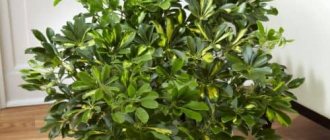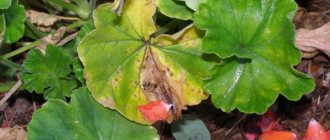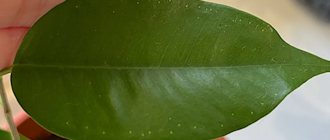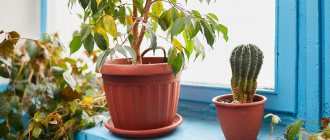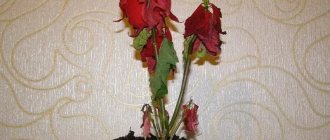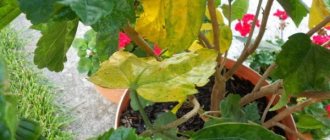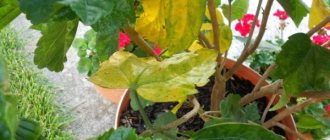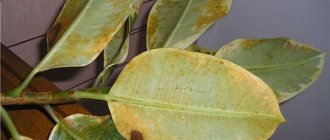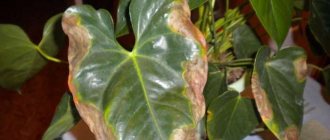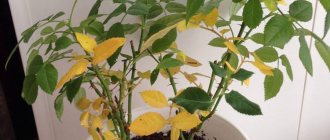Why do Schefflera leaves turn yellow and fall off? What to do. Other possible causes of leaf drop
Sometimes the reasons may be:
- Incorrect feeding regime;
- Lack or excess of light;
- Pests of indoor plants.
Insufficient feeding of the plant can lead to a slowdown in its development.
Loss of leaves can only be caused by keeping the plant in the same soil for many years without applying fertilizer. But an excess of fertilizers, and especially nitrogen compounds, leads to damage to the root system. At the same time, the Schefflera leaves turn yellow and fall off. Shefflera should be fertilized very carefully and only in the spring and summer.
Schefflera loves bright, diffused light, but can also tolerate partial shade. The condition of its leaves can only be affected by prolonged exposure to shade or direct sun. A lack of light leads to yellowing and falling of the lower leaves of the plant. If the flower stands in direct sun, light spots - burns - form on its leaves. Over time, the leaves dry out and fall off.
If damaged by spider mites, scale insects or aphids, plants may turn yellow and fall off. But this happens when pests have multiplied on the leaves in very large numbers. To prevent this, you need to regularly inspect the shoots and leaves.
If harmful insects are detected, the flower should be treated with insecticides. As a rule, the treatment is repeated to completely destroy the pests.
Pests
Schefflera is usually attacked by parasites:
- Mealybug. Its presence is easy to see with the naked eye. White cottony discharge appears on the leaves and trunk of the flower, turns yellow, and falls off;
- Shield. The waxy bodies of this parasite firmly adhere to the inner surface of the leaves, causing brown spots to appear on them. The plant slows down and withers;
- Spider mite. Its presence is revealed by the threads of the web that cover the entire plant. Shefflera leaves turn yellow, wither and fall off.
You can fight pests using a regular soap solution (laundry soap) or diluted alcohol. The leaves are treated with a cotton swab dipped in one of these solutions.
If the damage is severe, Scheffler needs to be sprayed with any insecticidal solution. During treatment, the flower is isolated.
Taking into account the advice in this article, you can easily determine the cause of your green beauty’s illness and help her cope with it.
Why do Schefflera leaves turn yellow and what to do. What to do if the cheflera turns yellow and drops its leaves?
Growing sheflera at home: why does it turn yellow? Read what reasons influenced the changes in Schefflera leaves? What causes an umbrella tree to shed its leaves?
Schefflera turns yellow and drops its leaves
The playful name for Schefflera, which bears the name of a famous German botanist, is the umbrella tree. Most gardeners want to get their hands on an Asian plant because of its exoticism, but at the same time, amazing closeness to Slavic taste. To maintain the house, chefs use a southern or eastern location saturated with sunlight. The plant is extremely susceptible to changes in lighting conditions, which it does not forget to remind you of in case of inappropriate care. The tree is afraid of drafts, so it obviously will not survive in cool rooms, near uninsulated balconies or open windows.
Why does the cheflera turn yellow and drop its leaves:
- Natural aging;
- Reduced air temperature;
- Few nutrients in the soil;
- Improper watering;
- Bad place;
Flower growers note the yellowing of sheflera leaves in the autumn. The reason for this is natural withering. The plant gets rid of some of the old leaves in order to lay new, green and stronger leaves in the spring. If the leaves turn yellow and become covered with a sticky coating or fall off at the wrong time, you need to think about other reasons.
Air temperature
Sheflera needs to be kept at a temperature of +22 ° C. Like lighting, the temperature must be kept above zero at all times. There is no need to raise it, creating the tropics, but a comfortable home one will suit you just fine. Problems begin when the cheflera freezes slightly. The symptoms are especially pronounced if the plant is flooded or sprayed in a draft. It is better to reduce watering for a while by restoring the sheflera. Follow developments.
Nutrients in the soil
Schefflera is fed regularly. If there is not enough fertilizer, it turns yellow, starting from the lower leaves. other problems with the soil mixture, such as too dense a ball of earth, lack of loosening, replanting was carried out a long time ago, etc. cause similar indicators. The cheflera also reacts poorly to any interference in her peace - she drops her leaves instantly, which is why they refuse to replant for so long.
It is carried out by completely changing the soil substrate, but without removing the root balls, otherwise the small hairs will be damaged. It is necessary to apply “Epin” or “Zircon”, also treating it during the transplantation process, in order to protect against unforeseen consequences. How to move the shefflera without causing too much damage: transfer it from one pot to another.
Watering chefleras
The plant is watered moderately. Unlike its brutal appetite for light and temperature, the plant prefers moderation in moisture. The result of frequent and unconditional procedures can be yellowing of the foliage. Since the roots are hypersensitive, they rot quickly, then restoration takes longer and is more difficult - it’s better not to allow them to do so.
Bad place
At the beginning of the article, we already considered the main criteria for placing shefleras in the house, which must be adhered to. Find a comfortable place for the plant with plenty of lighting, warmth, without drafts and temperature changes. It is advisable that the cheflera’s leaves should not be touched again, not torn off, or the tree moved - the cheflera will also react extremely sharply to such tenderness. If yellowing is caused by stress, it is enough to water it with Epin to calm the nervous plant.
Reproduction methods
Cuttings
In the spring, semi-lignified cuttings are cut, rooted in a substrate or water, and left in a warm place. For good root formation, it is optimal to treat sections of cuttings with a stimulator.
The cutting, which took root in water, after the roots appear, is planted in a soil substrate, covered with a plastic bag with holes, which must be removed every day for 20-30 minutes for ventilation.
If the process of rooting the cuttings took place in the soil substrate, put the bag on immediately, removing it daily for ventilation. The soil mixture is watered moderately to avoid excessive moisture.
Seeds
Sowed in winter, possibly in March. The seeds are placed in the soil mixture to a depth of 0.5 cm, watered, covered with plastic film, and placed in a room with an air temperature of +22...+25 degrees. The container for sowing must have drainage and holes to remove excess moisture. The film is removed daily for ventilation.
After 30 days, shoots appear, then the container should be moved to a well-lit place with a temperature of +15...+17 degrees. When the weather becomes hot and dry, the seedlings are sprayed with water at room temperature.
Children or offspring
In spring, you need to cut a non-main stem, wrap it in damp cotton wool or moss, and wrap it in film. It is necessary to ensure that the cotton wool or moss is constantly moistened. After 40-50 days, roots will appear, after which the cuttings are carefully separated from the mother stem and planted in a pot.
Why do Schefflera leaves turn yellow and fall off? What to do. Schefflera leaves turn yellow. Why? What to do?
A detailed explanation from experts about why Schefflera leaves turn yellow. What to do with sticky schefflera leaves? Photo, description of the problem and effective treatment.
Schefflera leaves turn yellow due to the natural cause of aging. In this case, we are talking about foliage that is about three years old and is located in the lower part of the plant. Experts do not see a problem with the lower leaves of sheflera turning yellow if this happens in the fall and is not widespread. However, you need to pay attention to the conditions under which the flower is kept. If they have not changed and the flower previously felt normal, and then began to lose its lower leaves, then this should not cause confusion. If the conditions of the plant have changed for the worse (low light level, waterlogging of the soil) and the leaves of the sheflera begin to turn yellow and fall off, then it is necessary to provide the flower with normal care.
Why does shefflera shed its leaves? In conditions of low temperature and high soil humidity, shefflera often sheds its leaves. This can be either old or young foliage. Waterlogging of the soil can occur due to excessive watering or improper soil (with increased moisture capacity). The plant may be planted in a pot that is too large. What to do? Due to excess moisture and low temperature in the room, the roots of the sheflera rot. The affected flower must be removed from the pot and the roots examined. Trim the raised ones. Plant the flower in a smaller pot and place it under a greenhouse. Hold off on watering, water when the soil is completely dry, and spray frequently (2-3 times a day). The temperature of the flower should not be lower than +20…+22 degrees.
Why do cheflera leaves turn yellow if the watering regime is correct? One reason is that there are not enough nutrients or the roots are too crowded in the pot. In this case, you need to remove the flower from the pot without disturbing the integrity of the earthen ball. If the roots are tightly wrapped around the walls of the pot, replant them by transshipment. But the integrity of the earthen coma cannot be violated. Sheflera reacts very painfully to this.
The cheflera falls off. What to do? Often, shefflera leaves turn yellow and fall off after changing conditions. For example, a newly purchased plant was moved to a new place of residence, that is, to the owner’s apartment or house. Often in a new place there is a different level of air humidity, light and temperature. Shedding leaves is a reaction to a change in living conditions. After purchase, the plant must adapt to its new place of residence, and therefore it is not recommended to replant or feed it for 1 month (the period does not have a clear framework). The plant successfully survived the adaptation period when leaf fall stopped and new foliage began to grow. In order for the adaptation period to pass faster and the shefflera to no longer shed leaves, she needs bright, diffused light. In winter, the flower must be provided with artificial lighting for at least 12 hours a day. To maintain the root system, you can add cycron to the water for irrigation (1 drop per 200 ml of water). Add epin to the water for spraying (2 drops per 200 ml of water). You need to water the flower abundantly, but only after the soil has dried. Spraying is carried out at least 2 times a day. But it all depends on the temperature of the content. The higher it is, the more often the chefler needs to be sprayed. In summer, the optimal temperature is +20...+25, in winter (forced period of rest) - the optimal temperature is +14...+20 degrees.
Diseases
Why does Schefflera shed its leaves?
There are several reasons why an umbrella tree might do this:
- Hypothermia. Schefflera loves coolness, but not drafts and cold (below 13 degrees). If the leaves fall but the trunk is still alive, you can save the flower. To do this, you need to place it in a warmer place, protected from drafts;
- Overheat. The plant is light-loving, but has a negative attitude towards direct sunlight;
It is necessary to change its location to a more comfortable one. In hot weather, spray 2 times a day.
- Low air humidity. In the autumn-winter period, you should keep the plant away from radiators, otherwise leaf fall is inevitable;
- Excessive waterlogging. The frequency of watering the shefflera depends on its place of residence. If it is on the sunny side, the soil dries faster and watering should be done more often with well-settled water. If the flower is in the shade, you should not overwater it, as this can lead to rotting of the root system and falling leaves. In this case, it is necessary to replant it, after removing the rotten part of the roots. Before planting in another container, the root system should be treated with a fungicide or root;
- Lack of light;
- Sudden change of location. Schefflera loves constancy and does not tolerate sudden movements. This is stressful for her and one of the reasons for shedding leaves. It is better to immediately choose the most comfortable place for the “umbrella tree” and not bother it with moving in the future;
- Dense soil and lack of drainage can also cause sudden leaf fall. The soil should be changed to a looser one. Place expanded clay drainage at the bottom of the pot.
They fall off and turn black
Leaves fall for the following reasons:
- Overflow. The plant should not be flooded; excess moisture can cause rotting of the root system and, as a result, blackening and falling off. Watering is necessary when the top layer of the substrate is dry. If there is water left in the tray of the pot after watering, it needs to be drained. If the root system is damaged by rot, shefflera can only be saved by replanting;
- Cold. If you water the shefflera with cold water in a draft or in a cold room, it can catch a cold and get sick. The leaves will begin to turn black and fall off. Watering should be done with well-settled water and the plant should change its place of residence to a more comfortable one;
- Sunburn. As a result of an excess of sunlight, the leaves darken and fall off.
Brown spots
In Schefflera, brown spots on the leaves appear for the following reasons:
- Excessive waterlogging or insufficient watering. Watering the plant should be moderate; you should not allow either waterlogging or drying out of the soil (the appearance of drying cracks on the soil surface);
- Pest damage (scale insects). Scale insect disease also causes the flower's leaves to turn brown and fall off.
Turn yellow and fall off
The Schefflera flower loses its leaves as a result of the natural process of yellowing and dropping of the lower leaves of the adult plant.
This is fine. This disease is associated, first of all, with a violation of the rules of maintenance. If you notice any signs of ill health, then it is necessary to eliminate the problem of care.
Thus, the cause of the fall may be:
- Overmoistening of the soil. It is necessary to reduce watering;
- Lack of nutrition. In this case, the plant should be fed with nitrogen fertilizers (bird droppings);
- Lack of light;
- Drafts.
- Pest infestation. In this case we are talking about mealybugs and spider mites;
The ends are drying out
- Dry air . It is necessary to spray 2 times a day, especially in the summer. In winter, the frequency of spraying is reduced, the plant is placed away from central heating radiators. Spraying helps temporarily. In hot weather, it is advisable to place the plant on a tray with wet expanded clay;
- Drafts can also cause leaf edges to dry out.
Why isn't Schefflera growing?
- Lack of fertilizers. The plant needs feeding;
- Transfer. For healthy growth and the appearance of large Schefflere leaves, replanting is necessary every 2 years.
Why do Schefflera leaves turn yellow and the leaves fall off? Schefflera sheds leaves: what to do?
Failure to comply with any of the listed conditions for keeping the plant may cause leaf shedding. For example, with sudden fluctuations in room temperature, unusually low or high thermometer readings. How to save the cheflera? When the foliage darkens and falls, you should pay attention to the trunk. If it is alive, then you can save the flower by transplanting it. Dry branches are cut off, the sections are treated with an antiseptic, and the plant is transplanted into a new container by transfer, without disturbing the root system.
Loss of leaves and rotting of roots is caused by excessive watering. It is especially dangerous at low temperatures. In such cases, the shefflera sheds its leaves. What to do? The plant is successfully revived by removing all the rotten roots, washing them and keeping them in the Epin solution for a couple of hours. Then the root system is treated with a fungicide and the plant is transplanted into new soil. The leaves are also sprayed with Epin solution, and the plant is packed in polyethylene for 2-3 days for disinfection. It is necessary to periodically remove the covering for ventilation. After restoring the shefflers, you need to adjust the watering, carrying it out only if the earthen clod dries out.
Insufficient air humidity can cause leaves to turn black and fall off. It can be easily eliminated. It is recommended to spray the plant several times a week and keep it as far as possible from heating devices.
Drafts have a detrimental effect on the chefler. The leaves dry out and become brittle. Indoors, you should choose a place that is not exposed to air currents and place a pot with a plant there.
The appearance of brown spots on leaves may be a consequence of insufficient soil aeration. The soil in which sheflera grows must be breathable. It is necessary to check for drainage.
Improper care or conditions
Most often, the sudden falling of flower leaves is associated with improper care or unsuitable microclimate conditions in the room. In this case, you need to carefully analyze all the external factors affecting the shefflera and find the reason for the fall of the green mass. Only after this can concrete actions be taken to eliminate the problem.
Poor lighting or direct sunlight
For normal growth, Schefflera needs bright, diffused light. With a lack of lighting, the leaves of the flower begin to wither and turn yellow, and then fall off. In direct sunlight, the flower may develop sunburn.
If the cause of the falling is improper lighting, then you can solve the problem using the following actions:
- if possible, place the pot with the plant near the eastern or western windows - in such a place the sheffler will receive a sufficient amount of light, but will not be exposed to direct sunlight;
- in rooms with southern windows, place the flower at a short distance from the window so that direct rays of the sun do not reach it;
- in darkened rooms, as well as during short daylight hours, use artificial lighting.
Failure to comply with the watering regime
This fact is the most common reason why Schefflera leaves fall off.
As a result of improper watering, phenomena such as:
- rotting of the roots of a flower with a significant excess of moisture in the soil, especially in a cold room;
- drying out of the earthen coma and death of the root system due to lack of water.
At the initial stage, it is easy to fix this problem. To do this, it is enough to adjust the watering regime and trim those leaves of the flower that are completely dry.
But if the Schefflera root system is also damaged, then more serious actions need to be taken:
- Remove the plant from the old pot and carefully examine all its roots.
- Cut off rotten, damaged and dead roots.
- Place the Schefflera roots in a solution of fungicide or Epin for a couple of hours.
- Replant the flower in fresh soil.
- Treat the ground part of the shefflera with Epin and cover it with a bag for 2-3 days.
- Adjust the plant’s watering regime, adding water only after the top layer of soil has dried.
Sudden changes in temperature
Schefflera does not tolerate heat and cold in the room. If the falling of the leaves of a flower was preceded by its prolonged exposure to a hot or cold room, then the cause of the problem lies in the incorrect temperature conditions. Schefflera also reacts negatively to sudden temperature changes.
Actions to save the plant should begin immediately after the first signs of shedding the green mass were noticed. If you leave this problem unattended, then the trunk of the flower will begin to dry out along with the leaves. In this case, it will no longer be possible to save the sheffler.
To fix the problem, you need to do the following:
- Carefully trim off all dry leaves and branches.
- Cauterize the cut areas with powdered activated carbon.
- Dig the Schefflera out of the old pot along with a lump of earth and replant it in new soil.
- Place the flower in a warm room with a temperature of +17. +22 °C. Avoid temperature changes.
Drafts
Schefflera needs fresh air, so the room with the plant needs regular ventilation. But if the flower stands in a draft, the leaves will not fall off. Within a day after the shefflera is constantly at the intersection of air flows, the tips of its leaves will begin to dry out.
To prevent the foliage of a flower from falling, you need to do the following:
- Trim off any yellowed leaves.
- Remove the pot with shefflera from the draft.
- In the warm season, cover the flower with a thick cloth while airing.
- Move the plant to another room for ventilation if the air temperature outside is much lower than indoors.
Dry indoor air
Sometimes the cause of plant leaves falling off is too dry air in the room. If Schefflera is grown in a stuffy room with low humidity and dust collects on its leaves, they may begin to turn yellow and fall off.
To help the plant and stop its leaves from falling, you need to maintain a higher than average humidity level in the room.
This can be achieved using the following actions:
- Spray the flower leaves with water daily and periodically wipe them from dust with a damp sponge.
- Place the pot with the plant near the aquarium or on a tray with wet expanded clay.
- Use automatic humidifiers.
Excess of mineral fertilizers
For normal growth, Schefflera needs regular feeding, but excess mineral fertilizers can lead to burns to the roots of the flower. As a result, the leaves of the plant turn yellow and fall off, and if measures are not taken in time, burns to the roots can lead to the death of the shefflera.
Why do Schefflera leaves turn yellow and fall off? Content problems
To enjoy the beauty of this amazing indoor flower, you should know not only how to care for the cheflera, but also be aware of its possible diseases:
- Despite the fact that this exotic plant is not susceptible to diseases and pests, there are still parasites that can live on it. Scale insects, red spider mites, and thrips are the main enemies of shefflera. To eliminate these pests, plants are sprayed with special chemicals.
- Sometimes the leaves of Schefflera turn yellow, turn black and fall off. There are several reasons why this happens. But most often it may be improper care. It is important to remember that planting and propagation of this indoor plant is carried out only in disinfected soil. Soil that has not undergone such treatment may contain fungal spores and pest larvae.
- If the leaves of a plant darken at the tips and fall off, this indicates excess moisture. It is recommended to replant such a plant in new soil to avoid root rot. After transplantation, the plant is not watered for several days. In winter, the sheffler should be watered less frequently, increasing daylight with artificial light. She will need 10 hours of daylight daily.
- Both excess and lack of moisture can cause a plant to lose its leaves. Here it is worth paying attention to the air humidity in the room. If the air is too dry, the leaves on the plant become covered with brown spots and fall off en masse. Therefore, it is very important to place the flower away from heating appliances in winter. You can place a container of water next to the flower, which, by evaporating, will provide the necessary humidity.
- Improper watering, fertilizing, as well as non-compliance with temperature and light conditions do not have the best effect on the general condition of the flower. If not properly cared for, the cheflera will not only stop growing, but may even die.
Home care
Schefflera is not particularly demanding of care at home, but properly organized conditions for the growth and development of the flower will provide it with a lush, beautiful crown.
Soil selection
The soil mixture must meet the following characteristics: be light in composition, nutritious, breathable, the pH of the soil solution must be in the range of 5.0-7.0.
Landing
It is best to plant young plants in early spring. 4 young sheffleras are usually planted in one container. A drainage layer is placed at the bottom of the flowerpot, and soil substrate is poured onto it.
Temperature
In spring and summer, the air temperature in the room should be in the range of +18...+20°C, in autumn and winter - within +12...+16°C. Do not place the flowerpot near heating appliances.
Lighting
Lighting should be diffused, but bright enough; in winter, additional lighting should be used.
Feeding
During the growing season (spring - autumn), the plant is fed once every 14 days with special microfertilizers.
Watering and humidity
Water the plant with soft water at room temperature, settled or purified. Do not over-dry or over-moisten the earthen ball.
Air humidity should be increased, for which the shefflera is regularly sprayed with water at room temperature.
Transfer
The plant is replanted every 2 years in early spring using the transshipment method. The pot for replanting is taken 5-6 cm larger than the previous one, since with proper maintenance the shefflera grows actively. A layer of drainage 2-4 cm high is placed at the bottom of the pot.
Trimming
The main purpose of pruning is to form a beautiful crown shape. To keep the crown round, cut off the top. If you want the plant to have a tree-like shape, you need to trim off the side shoots.
Spots on sheflera leaves. Common diseases
The second reason may be that the flower is cold. If the temperature is below +16 degrees, the plant will gradually begin to shed its leaves. In addition, the reason may be improper watering. Due to excessive soil moisture, if water stagnates in a pot or tray, the plant will also begin to quickly get rid of leaves.
If the leaves of your favorite plant become lighter, duller or turn yellow, this indicates that the flower needs additional feeding. There is no need to do anything special to improve the health of the plant. As a rule, such a problem can be solved by complex fertilizer. Try to fertilize 3 times a month. It is important to maintain equal intervals between feedings. Remember that shefflera especially needs feeding from April to September.
If the upper leaves begin to fade a little, this indicates a lack of light. It’s easy to get rid of this problem; you just need to find a comfortable place for the flower. It is important to remember that this species must be protected from direct sunlight, but it should also not be grown in the shade.
Diseases and pests
Errors in agricultural technology often lead to various fungal diseases that disrupt the life activity of shefflera.
Low temperatures and high humidity can cause black rot to appear. The leaves begin to turn brown and then fall off. In addition, traces of mold can be seen on the surface of leaf plates and shoots. Fungal spores fall from the foliage and enter the soil, affecting the roots.
The life of the shefflera may worsen due to attacks by insect pests. A similar problem often occurs in dry air. Leaves fall due to attacks by mealyworms, spider mites, and scale insects.
Shchitovka
Spider mite
In this case, pests affect not only the foliage, but also the stem and root of the flower.
Schefflera for the home. Schefflera in the house - signs and tips
Some signs warn against keeping sheflera in the house. But this attractive and easy-to-care plant is still popular among indoor plant lovers.
In the article:
Schefflera in the house
Some blame the shefflera and forbid her to keep her in the house. This is partly true. The plant really knows how to take energy, but the vampire is quite weak. In addition, he prefers negative energy, which has no place in housing. Therefore, sheflera calms and harmonizes the energy of the house. It removes negativity and helps stop quarrels and scandals in the family. The best place for breeding is the bedroom, then it will contribute to sound sleep and productive rest, as well as strengthening the relationship between spouses.
Representatives of some esoteric teachings suggest that knowledge is better absorbed near this home plant. It is placed on the desktop of a schoolchild or student so that he can more productively and quickly absorb information about the sciences he is studying.
It should be remembered that sheflera is a poisonous plant. Many signs, upon closer examination, endow poisonous or strong-smelling plants with such negative traits as energy vampirism.
Schefflera - a predictor plant
There are a number of signs that a cheflera can do this. Many people are so afraid of bad omens that they do not want to notice that this plant also predicts pleasant events. Therefore, it is considered undesirable to keep it in the house, because this way you can find out about impending troubles.
If the Schefflera leaves have darkened, there is a lot of negative energy in the house. Perhaps you should use magic, pay attention to your surroundings - they may cast spells on you.
If a plant drops its leaves, this is also a bad omen. It predicts the illness of a family member or financial failure, and sometimes both. Sheflera leaves are folded before a quarrel or scandal in the family, with friends or colleagues.
If it blooms, but at some point stops growing, expect failure. Most often they are associated with material values, family income or career.
If the cheflera suddenly begins to grow quickly, it means pregnancy. This is the only sign of a positive nature that is associated with a change in the state of the plant.
Schefflera - a plant of money and prosperity
Most of the bad things about this plant are related to career and money. Therefore, it is believed that if you care for it correctly, it brings money.
To attract money, a chef can work at home or in the office. At the same time, the choice of place for it does not play a big role. Its meaning in the home is to attract prosperity for all family members. In the office, the cheflera attracts clients, business partners, facilitates the conclusion of profitable contracts and increases profits. If you want to increase your income or achieve a salary increase, plant this plant near your workplace.
This one most actively helps people born under one of the fire signs of the zodiac - Leo, Sagittarius and Aries, but it is suitable for everyone.
General information
List of the main reasons leading to the poor condition of the cheflera
There are plenty of reasons why a houseplant's leaves fall. Therefore, when this starts to happen, it can be very difficult to determine the true cause.
Among the most common are:
- there is too much difference in temperature between the permissible temperature and what actually exists;
- high air humidity or, conversely, dryness;
- non-compliance with the liquid application regime;
- excessive application of fertilizers without observing recommended dosages;
- inappropriate lighting for growing sheflera;
- the presence of insect pests on the crown or roots.
Knowing all the reasons why a flower sheds its leaves, we can identify the main reasons for this event.
If we talk about watering, then it is important to find a middle ground, because both its deficiency and its excess are harmful. Each of the features of this procedure has its own effect, and when overwatered, the leaves do not dry out, but become covered with spots, after which they begin to turn black and fall off.
If cold air temperatures are added to abundant watering, putrefactive processes in the root system may begin to develop at an accelerated pace. This also leads to the loss of sheflera leaf plates.
Important! At home, along with excess humidity, shefflera is also affected by its lack, including in the air. Its dryness promotes the evaporation of moisture from the leaf plates and their subsequent fall.
In other cases, all of the above reasons are a gross violation of caring for a houseplant and, one way or another, can become one of the stimulants of crown baldness.
It should be taken into account that the yellow lower leaves on the Schefflera may be the result of natural life processes. If there are not many of them, then there is no need to worry. Excessive damage to the deciduous crown indicates diseases of the root system, which happens both from overwatering of the soil and from its drying out, as well as due to burns caused by using fertilizers in incorrect proportions.
Adaptation of sheflera at home
This plant has a very negative attitude even to simply moving the pot to a new place, not to mention a complete change of residence.
The chef experiences the greatest stress during the move from the store to the apartment. Often adaptation can be delayed and lead not only to yellowing of the leaf blades, but also to their shedding. To help the plant adapt faster, you need to create the most suitable conditions in the initial stages. To do this, do not water the soil abundantly, and place the pot directly on a window with direct sunlight. In order for the flower to quickly get used to a new place, the pot with it is placed away from bright light and moderate watering is provided without the use of fertilizers. Only when a decrease in the number of fallen leaves and the appearance of new shoots is noticed, can you choose a permanent place for growing indoor crops. Since that time, standard care procedures for the cheflera have been used.
Interesting! Knowing about such a feature of cheflera as a dislike for changing places, it is better not to touch it again, and think through all the next steps in advance, and choose a suitable window sill for growing. If the plant is under severe stress, you can try using a solution based on Epin.
How to save a shefflera. #3 MirLana
Sent
A photo would be nice. How tall are sheffleras? IMHO: During transplantation, the roots were injured, then they flooded. I dry mine on the knuckle of a finger in the summer and up to about 1/2 of a pot in the winter. She is much less afraid of drought than the flood. It’s better to spray one more time than to water it. And two meters from which window? Mine is located in the south-west with light shading - in partial shade it grew very slowly, accordingly: the less light, the easier it is to flood it. And one more thing: if it falls out of the ground, you risk losing the last roots. It must be fixed - tied to a support. Otherwise, new damage will occur. In a humid environment they can rot again. And be sure to sprinkle them with coal. What kind of soil is it sitting in? What type of shefflera? Green or variegated? The latter is more capricious. I would do this: If it is large, put the crown for rooting (it is better to treat the cut with heteroauxin or root and place it in a warm, bright place under a cap), the rest into the pot along the root. If it’s small, I wouldn’t risk cutting it. Place thick drainage (expanded clay, for example) on the bottom, then sprinkle it with crushed coal and loose soil. For Scheffler, I make approximately the following mixture: Vita Terra (or for dracaenas) + coarse sand + red brick (crushed smaller) + vermiculite + coal). Soak for a couple of hours in zircon, then a little (15 - 30 minutes) in phytosporin. Sprinkle the roots with coal and plant them firmly in place. Do not water the ground (there is enough moisture in the store), spray with zircon. When the leaves are dry, put under the bag, but only the tops. It is better to leave the ground open. The first watering is only after it has dried somewhere on the phalanx. It's better to just spray it well. It is normal to water only after new growth. New leaves will appear, which means the roots have already grown.
Details
Overview of problems and causes
Dropping leaves due to dry air
Dry air is a common phenomenon in city apartments. In the summer this happens for natural reasons, which are associated with extreme heat, in the winter - due to the operation of heating devices. For sheflera, such an environment is not considered favorable; dry air leads to curling of the leaves, after which they wither and fall off. Low air humidity can cause pests.
If the air in the apartment is very dry, this needs to be corrected. Increasing its humidity will be useful not only for sheflera, but also for other house plants. The simplest method is regular spraying with a spray bottle. In winter, when the battery is running and in the intense summer heat, such procedures are carried out twice, in the morning and in the evening. In the fall, before the batteries are turned on, you can do this a little less often.
To ensure a suitable microclimate, the flowerpot with sheflera can be placed in a separate tray with water, in which expanded clay, pebbles or sand are laid out. But so that the water does not reach the bottom of the pot.
If you choose among modern options, it is enough to purchase a household humidifier and turn it on periodically, not far from indoor plants.
Changes in the chefler's condition due to lack of nutrition
When this houseplant lacks nutrients, it begins to shed its leaves. This allows you to save the already minimal supply of minerals to maintain life support.
To change the situation, the flower must not only be regularly replanted in fresh soil, but also nourished by adding fertilizers from external sources. If the crown is still turning yellow, this is only the beginning of the process, but when it falls off, everything becomes much more serious. In this case, you need to use a complex fertilizer with a high nitrogen content. This component has a positive effect on the development of the green part of the plant crop and will help restore its mass.
It is important to always follow the instructions for applying complex fertilizers, because an excess is just as fraught as a lack. Fertilizer can be added in the spring-summer period and this action can be eliminated in the winter during the resting phase.
Temperature level for well-being schefflera
In conditions of low temperature in the room, especially if the soil is waterlogged, the root system may begin to rot. This condition is regarded as particularly dangerous and the main symptom is yellow leaves falling off.
The last phase of this disease is considered to be the transition of rot to the superficial part of the sheflera, or rather to its shoots.
Important! In order for the cheflera to develop normally, it must be kept at a temperature of +18-22. A decrease in these indicators can only be allowed for a short period of time. When natural cooling is delayed, the cheflera quickly reacts by changing the color of the crown.
This issue needs to be resolved quickly enough, especially if the roots are rotting. The plant will require immediate replanting, but first the earthen ball is removed from the pot for a preliminary inspection. All rotten areas are cut off to healthy white tissue, after which the remaining part is treated with a fungicide. Only after this can the shefflera be moved to fresh soil and a new pot. An old flowerpot can also be used, but only after it has been disinfected.
To create suitable temperature conditions for sheflera, you need to avoid exposure to drafts. Constant gusts of cold air affect the color of the leaf blades and their number.
Along with cold weather, intense heat will also harm the cheflera. In the summer heat, the condition can be alleviated by regular spraying or moving the pot to a more shaded place. In winter, it is better to place it away from heating appliances.
Excess water as a cause of yellowing of Schefflera leaves
Schefflera reacts negatively to stagnation of liquid in the pot. The ideal interval between waterings is 5-7 days, allowing the top layer of soil to dry out. In hot weather, you need to water a little more often, allowing the soil to dry out to a depth of 3 cm.
Important! Violation of watering norms is the most common reason that leads to sheflera leaves turning yellow and falling off. If water is added without allowing the soil to dry out beforehand, the root system will begin to rot, and the leaves will wither and darken.
Dealing with root rot is quite difficult, and if this problem is identified in the initial stages, you can try to simply dry the soil. If the process has moved to the upper parts of the plant, replanting is necessary.
What does lack of light lead to?
Schefflera is considered a southern plant and needs plenty of light for quality development. It is the lack of lighting that can lead to a change in the color of leaf plates from natural to pale and yellow.
To create optimal conditions, the pot with the plant should be placed close to the window and provide diffused lighting. Southern window sills with a light curtain on the glass are ideal.
If the chefler is placed on the north side, additional lighting will be needed using special lamps. Creating 12 hours of full light would be ideal.
Choosing a suitable pot for sheflera
The plant may begin to shed leaves if the volume of the pot is too large, which leads to stagnation of moisture and rotting of the roots. A cramped pot can also cause such circumstances, due to the fact that there are no nutrients left in the soil.
To the question of what to do in such a situation, there can only be one answer - timely replanting of the sheflera, especially if the container is too large and the putrefactive process has begun in the roots.
Damage to roots due to replanting
The root system can be damaged in other ways, and this mainly happens due to careless handling of the plant. The cheflera reacts very painfully to the loss of the slightest part of its root system. With severe damage, the plant not only begins to shed its leaves, it can die in a short time.
In order not to cause damage to the roots, you need to replant the flower very carefully, using the transshipment method and maintaining the same earthen lump.
Interesting! If the roots were damaged while changing the pot, you can immediately use one of the growth stimulants, which will facilitate rapid adaptation and growth of the root system.
Diseases and pests
Diseases leading to loss of foliage
As already mentioned, putrefactive processes are the most dangerous for sheflera; they can start for various reasons, but the main ones are cold air and overflow.
It is not enough to simply solve this problem by transplanting; you need to understand what led to it so that it does not arise again. Care should be taken to organize the correct watering regime and create suitable temperature conditions.
Schefflera pests
Schefflera in the house can usually be attacked by the following insects:
- Scale insects, which stick to the leaves from the inside and provoke the appearance of dark spots on them. If you do not collect this pest and do not treat it, the cheflera will stop growing and wither away.
- Mealybug, which can be easily found on the surface of the plant. It leaves cottony white marks on the leaves.
- A spider mite that leaves a thin web on the plant. This insect sucks the juice from the surface of the leaves, which leads to the appearance of spots and their fall.
To prevent the spread of harmful insects, you need to periodically carry out preventive inspections and timely treat the surface using a soap solution. If the condition is regarded as advanced, the use of professional insecticides will be required.
Important! If harmful insects are found on one of the plants, it must be isolated until complete recovery. .
Main Possible Causes
There are many reasons for Schefflera leaves to fall off. Therefore, when it begins to lose leaves, it can be difficult to determine the cause. Here are the main reasons why Schefflera leaves fall:
- Incorrect watering regime;
- Temperature too low or high;
- Unsuitable air humidity for the plant.
There are other reasons:
- Excess feeding;
- Incorrect lighting;
- Presence of pests.
Most often, improper watering causes leaves to fall off. It can be either too intense or not enough. Although too much and too little moisture affects the plant differently, the plant responds by shedding its leaves.
The temperature regime is also very important for the plant.
Thus, a low temperature in combination with abundant watering very quickly causes stagnation of water and the development of putrefactive bacteria. And this is reflected in the condition of the flower, which, as it rots, begins to lose its leaf blades. The falling of plant leaves is most often affected by insufficient humidity. Dry air causes leaves to dry out and fall off.
High humidity can cause leaf fall only in combination with abundant watering. This growing regime promotes rotting of flower tissues. Other reasons lead to loss of leaves extremely rarely and only in case of gross violation of the rules of care. If the plant is fed too intensively or placed in direct sun, if pests infest it, then it will most likely not be possible to preserve its foliage.
Why do leaves turn yellow, turn black, or wither before falling off?
Even before the Schefflera leaves begin to fall, you can identify errors in caring for the plant. You should not wait for the leaves to fall, as the flower will lose its beauty for a long time. Diagnosis is carried out according to the condition of the plant. Leaves before falling may:
- turn yellow;
- To darken or turn black;
- Fade.
Yellowing and falling of the lower leaves of Schefflera is a natural process. If there are only a few of these records, no need to worry. But massive yellowing indicates damage to the root system. This can happen as a result of the earthen clod drying out, which is extremely undesirable. Also, yellowing of the leaves occurs when the roots are burned by fertilizers.
Usually, if a maintenance error is detected and corrected at the very beginning, the plant will recover and grow new leaves, but the yellowed blades will fall off. But if the plant has already lost most of its green mass, its roots cannot be restored.
Sometimes yellowing of some part of the crown is observed. Most likely, this occurs due to direct sunlight hitting the leaves. At the same time, you need to choose more suitable lighting for the flower.
Schefflera leaves turn black or darken and fall off due to a fungal infection. When the soil is systematically waterlogged, the plantains darken. They may turn brown or even black. Then they fall off. In this case, only replanting into new soil will save the plant from death. All rotten roots and damaged leaves must be removed, and the remaining plant must be treated with antifungal drugs.
Wilting can be observed with a significant increase in temperature. It is urgently necessary to reduce it, otherwise the leaves will begin to dry out and die. Wilting is also observed in open sun. Subsequently, such leaves become covered with burns and dry out. Now you know what to do if Schefflera sheds its leaves.
